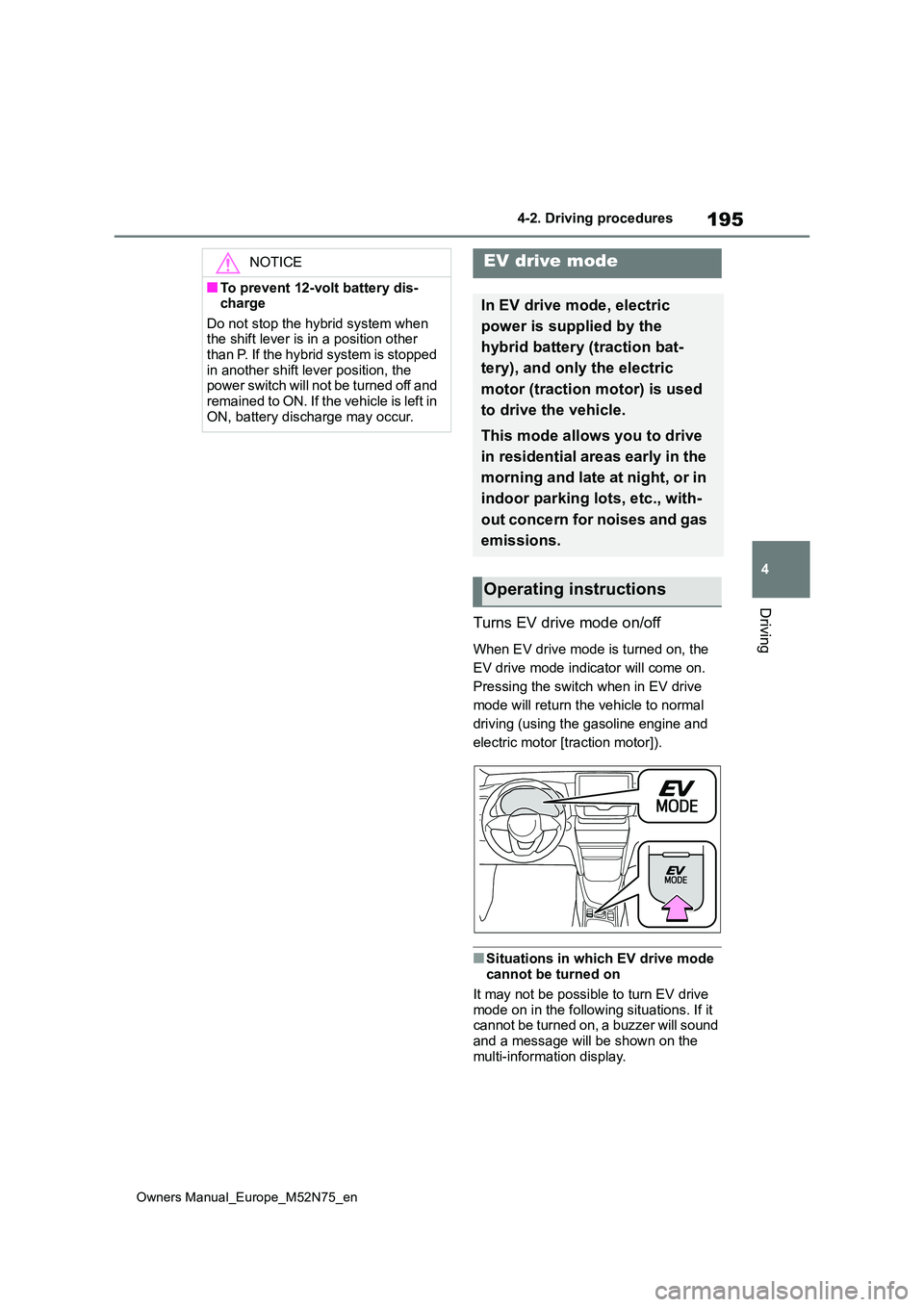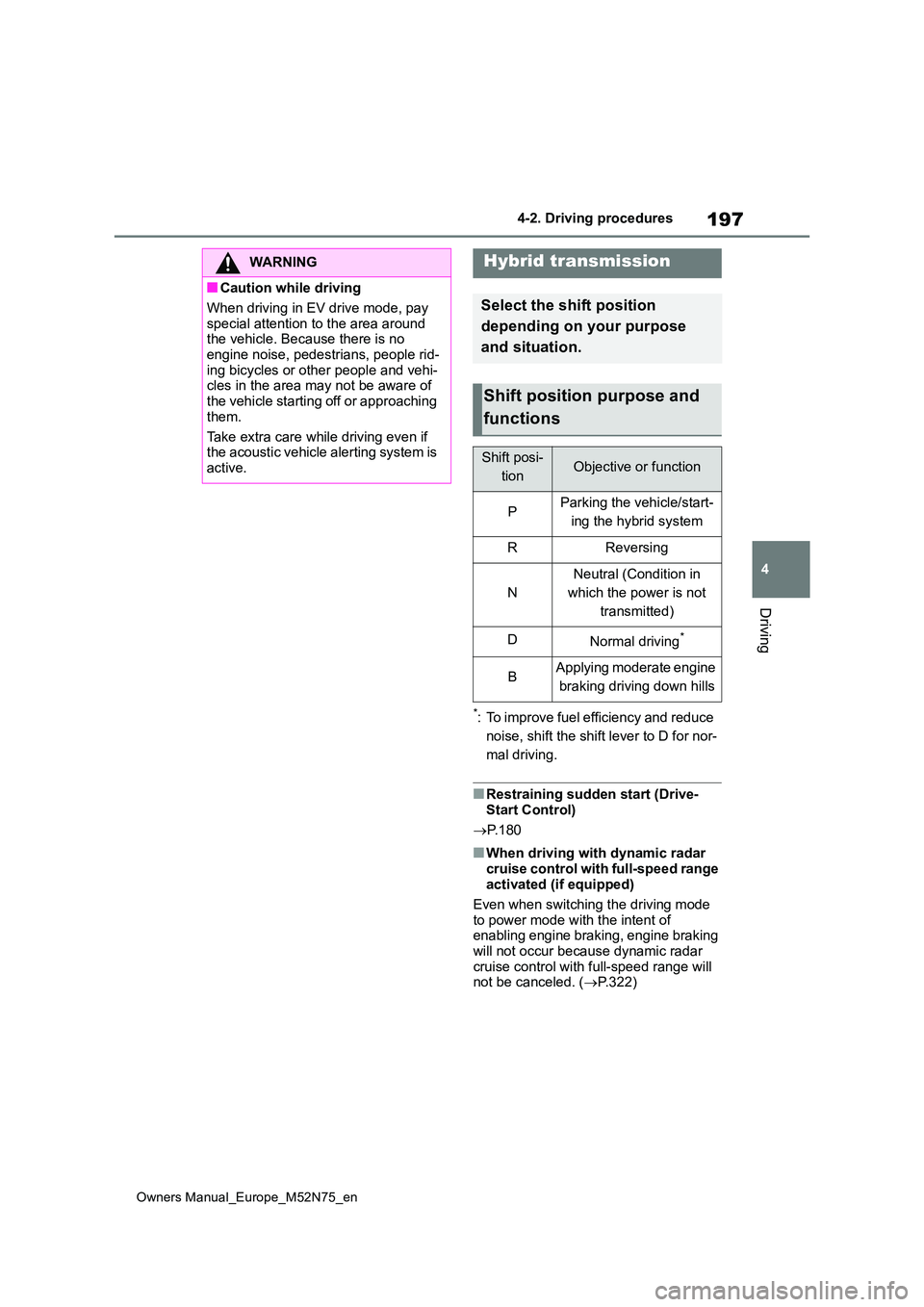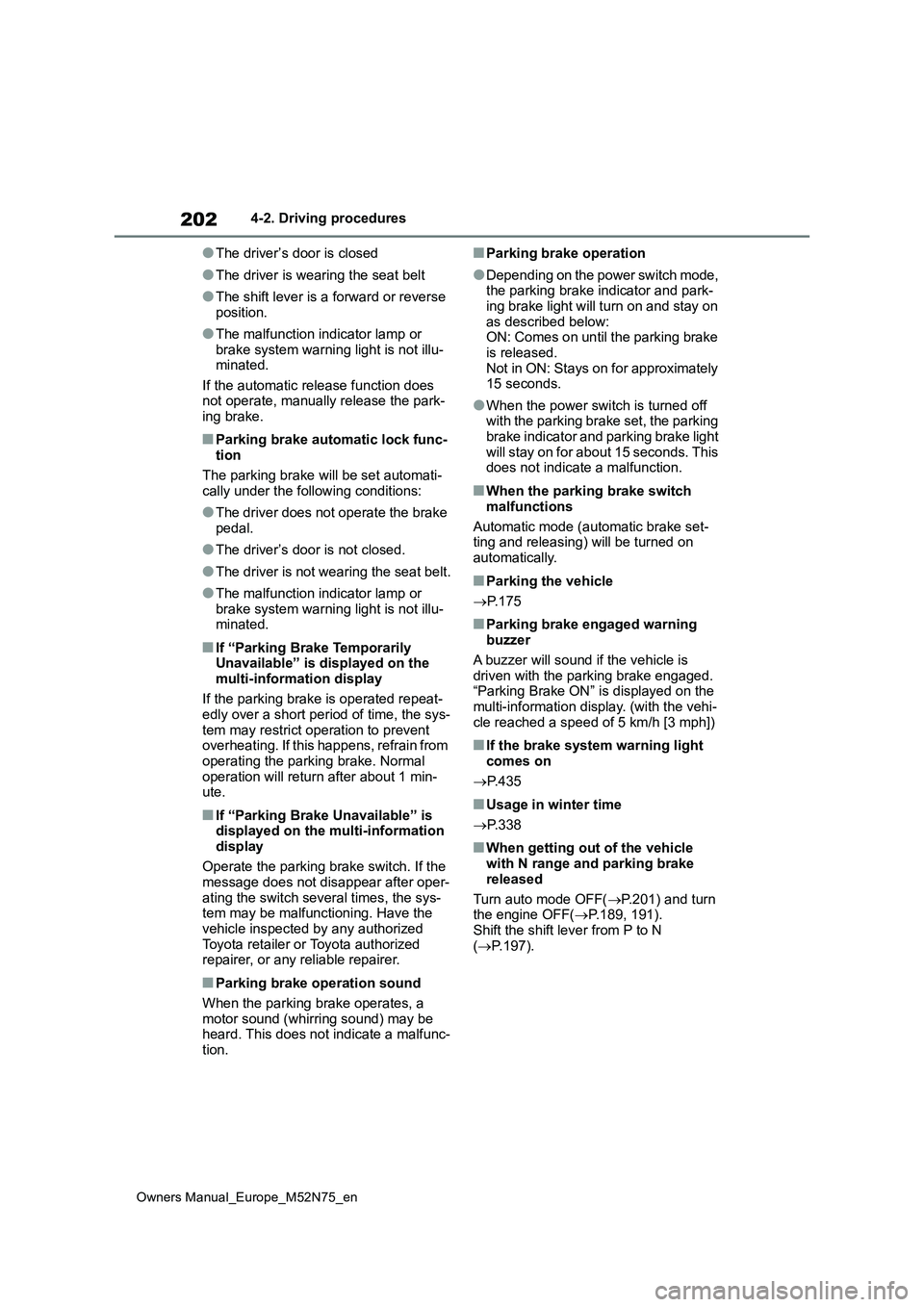2023 TOYOTA YARIS CROSS engine
[x] Cancel search: enginePage 197 of 698

195
4
Owners Manual_Europe_M52N75_en
4-2. Driving procedures
Driving
Turns EV drive mode on/off
When EV drive mode is turned on, the
EV drive mode indicator will come on.
Pressing the switch when in EV drive
mode will return the vehicle to normal
driving (using the gasoline engine and
electric motor [traction motor]).
■Situations in which EV drive mode cannot be turned on
It may not be possible to turn EV drive
mode on in the following situations. If it cannot be turned on, a buzzer will sound and a message will be shown on the
multi-information display.
NOTICE
■To prevent 12-volt battery dis- charge
Do not stop the hybrid system when the shift lever is in a position other than P. If the hybrid system is stopped
in another shift lever position, the power switch will not be turned off and remained to ON. If the vehicle is left in
ON, battery discharge may occur.
EV drive mode
In EV drive mode, electric
power is supplied by the
hybrid battery (traction bat-
tery), and only the electric
motor (traction motor) is used
to drive the vehicle.
This mode allows you to drive
in residential areas early in the
morning and late at night, or in
indoor parking lots, etc., with-
out concern for noises and gas
emissions.
Operating instructions
Page 198 of 698

196
Owners Manual_Europe_M52N75_en
4-2. Driving procedures
●The temperature of the hybrid system
is high. The vehicle has been left in the sun, driven on a hill, driven at high speeds,
etc.
●The temperature of the hybrid system
is low. The vehicle has been left in tempera-tures lower than about 0°C (32°F) for
a long period of time, etc.
●The gasoline engine is warming up.
●The hybrid battery (traction battery) is low.
The remaining battery level indicated in the energy monitor display is low. ( P.123)
●Vehicle speed is high.
●The accelerator pedal is depressed firmly or the vehicle is on a hill, etc.
●The windshield defogger is in use.
■Switching to EV drive mode when the gasoline engine is cold
If the hybrid system is started while the
gasoline engine is cold, the gasoline engine will start automatically after a short period of time in order to warm up.
In this case, you will become unable to switch to EV drive mode.
After the hybrid system has started and
the “READY” indicator has illuminated, press the EV drive mode switch before the gasoline engine starts to switch to
EV drive mode.
■Automatic cancelation of EV drive mode
When driving in EV drive mode, the gas-
oline engine may start automatically and the vehicle may be driven by the gaso-line engine and electric motor (traction
motor) in the following situations. When EV drive mode is canceled, a buzzer will sound, the EV drive mode indicator will
flash, and a message will be displayed on the multi-information display.
●The hybrid battery (traction battery) becomes low.The remaining battery level indicated
in the energy monitor display is low.
( P.123)
●Vehicle speed is high.
●The accelerator pedal is depressed firmly or the vehicle is on a hill, etc.
■Possible driving distance when driving in EV drive mode
EV drive mode’s possible driving dis- tance ranges from a few hundred meters to approximately 1 km (0.6 mile).
However, depending on vehicle condi- tions, there are situations when EV drive mode cannot be used.
(The distance that is possible depends on the hybrid battery [traction battery] level and driving conditions.)
■Fuel economy
The hybrid system is designed to achieve the best possible fuel economy during normal driving (using the gaso-
line engine and electric motor [traction motor]). Driving in EV drive mode more than necessary may lower fuel econ-
omy.
■If “EV Mode Unavailable” is shown on the multi-information display
The EV drive mode is not available. The
reason the EV drive mode is not avail- able (the vehicle is idling, battery charge is low, vehicle speed is higher than the
EV drive mode operating speed range or accelerator pedal is depressed too much) may be displayed. Use the EV
drive mode when it becomes available.
■If “EV Mode Deactivated” is shown on the multi-information display
The EV drive mode has been automati-
cally canceled. The reason the EV drive mode is not available (the battery charge is low, vehicle speed is higher
than the EV drive mode operating speed range or accelerator pedal is depressed too much) may be displayed. Drive the
vehicle for a while before attempting to turn on the EV drive mode again.
Page 199 of 698

197
4
Owners Manual_Europe_M52N75_en
4-2. Driving procedures
Driving
*: To improve fuel efficiency and reduce
noise, shift the shift lever to D for nor-
mal driving.
■Restraining sudden start (Drive- Start Control)
P. 1 8 0
■When driving with dynamic radar
cruise control with full-speed range activated (if equipped)
Even when switching the driving mode
to power mode with the intent of enabling engine braking, engine braking will not occur because dynamic radar
cruise control with full-speed range will not be canceled. ( P.322)
WARNING
■Caution while driving
When driving in EV drive mode, pay
special attention to the area around the vehicle. Because there is no engine noise, pedestrians, people rid-
ing bicycles or other people and vehi- cles in the area may not be aware of the vehicle starting off or approaching
them.
Take extra care while driving even if the acoustic vehicle alerting system is
active.
Hybrid transmission
Select the shift position
depending on your purpose
and situation.
Shift position purpose and
functions
Shift posi-
tionObjective or function
PParking the vehicle/start-
ing the hybrid system
RReversing
N
Neutral (Condition in
which the power is not
transmitted)
DNormal driving*
BApplying moderate engine
braking driving down hills
Page 200 of 698

198
Owners Manual_Europe_M52N75_en
4-2. Driving procedures
While the power switch is in ON,
depress the brake pedal and while
pressing the button move the shift
lever.
: While the power switch is in
ON and the brake pedal
depressed*, shift the shift lever
while pushing the shift release but-
ton on the shift knob.
: Shift the shift lever while push-
ing the shift release button on the
shift knob.
: Shift the shift lever normally.
When shifting the shift lever between P
and D, make sure that the vehicle is
completely stopped.
*: For the vehicle be able to be shifted
from P, the brake pedal must be
depressed before the shift release
button is pushed. If the shift release
button is pushed first, the shift lock
will not be released.
■Shift lock system
The shift lock system is a system to pre- vent accidental operation of the shift
lever in starting. The shift lever can be shifted from P only when the power switch is in ON and
the brake pedal is being depressed.
■If the shift lever cannot be shifted from P
First, check whether the brake pedal is
being depressed. If the shift lever cannot be shifted with your foot on the brake pedal, there may
be a problem with the shift lock system. Have the vehicle inspected by any authorized Toyota retailer or Toyota
authorized repairer, or any reliable repairer immediately.
The following steps may be used as an emergency measure to ensure that the
WARNING
■When driving on slippery road surfaces
Do not accelerate or shift gears sud- denly. Sudden changes in engine braking
may cause the vehicle to spin or skid, resulting in an accident.
NOTICE
■Hybrid battery (traction battery) charge
If the shift lever is in N, the hybrid bat-
tery (traction battery) will not be charged even when the engine is run-ning. Therefore, if the vehicle is left
with the shift lever in N for a long period of time, the hybrid battery (traction battery) will discharge, and
this may result in the vehicle not being able to start.
Shifting the shift lever
Page 201 of 698

199
4
Owners Manual_Europe_M52N75_en
4-2. Driving procedures
Driving
shift lever can be shifted.
Releasing the shift lock:
1 Set the parking brake.
2 Turn the power switch off.
3 Depress the brake pedal.
4 Ply the cover up with a flathead screwdriver or equivalent tool.To prevent damaging the cover,
wrap the tip of the flathead screw- driver with a tape.
5 Press and hold the shift lock override button and then push the button on the shift knob.
The shift lever can be shifted while the both buttons are pressed.
■About engine braking
When shift position B is selected, releasing the accelerator pedal will
apply engine braking.
●When the vehicle is driven at high
speeds, compared to ordinary gaso- line-fueled vehicles, the engine brak-ing deceleration is felt less than that of
other vehicles.
●The vehicle can be accelerated even
when shift position B is selected.
If the vehicle is driven continuously in the B position, fuel efficiency will
become low. Usually, select the D posi- tion.
P. 3 2 2
WARNING
■To prevent an accident when releasing the shift lock
Before pressing the shift lock override button, make sure to set the parking brake and depress the brake pedal.
If the accelerator pedal is accidentally depressed instead of the brake pedal when the shift lock override button is
pressed and the shift lever is shifted out of P, the vehicle may suddenly start, possibly leading to an accident
resulting in death or serious injury.
Selecting the driving mode
Page 204 of 698

202
Owners Manual_Europe_M52N75_en
4-2. Driving procedures
●The driver’s door is closed
●The driver is wearing the seat belt
●The shift lever is a forward or reverse position.
●The malfunction indicator lamp or brake system warning light is not illu-minated.
If the automatic release function does not operate, manually release the park-ing brake.
■Parking brake automatic lock func-
tion
The parking brake will be set automati- cally under the following conditions:
●The driver does not operate the brake pedal.
●The driver’s door is not closed.
●The driver is not wearing the seat belt.
●The malfunction indicator lamp or
brake system warning light is not illu- minated.
■If “Parking Brake Temporarily Unavailable” is displayed on the
multi-information display
If the parking brake is operated repeat- edly over a short period of time, the sys-
tem may restrict operation to prevent overheating. If this happens, refrain from operating the parking brake. Normal
operation will return after about 1 min- ute.
■If “Parking Brake Unavailable” is displayed on the multi-information
display
Operate the parking brake switch. If the message does not disappear after oper-
ating the switch several times, the sys- tem may be malfunctioning. Have the vehicle inspected by any authorized
Toyota retailer or Toyota authorized repairer, or any reliable repairer.
■Parking brake operation sound
When the parking brake operates, a
motor sound (whirring sound) may be heard. This does not indicate a malfunc-tion.
■Parking brake operation
●Depending on the power switch mode, the parking brake indicator and park-
ing brake light will turn on and stay on as described below:ON: Comes on until the parking brake
is released. Not in ON: Stays on for approximately 15 seconds.
●When the power switch is turned off with the parking brake set, the parking
brake indicator and parking brake light will stay on for about 15 seconds. This does not indicate a malfunction.
■When the parking brake switch
malfunctions
Automatic mode (automatic brake set- ting and releasing) will be turned on
automatically.
■Parking the vehicle
P. 1 7 5
■Parking brake engaged warning buzzer
A buzzer will sound if the vehicle is driven with the parking brake engaged. “Parking Brake ON” is displayed on the
multi-information display. (with the vehi- cle reached a speed of 5 km/h [3 mph])
■If the brake system warning light comes on
P. 4 3 5
■Usage in winter time
P. 3 3 8
■When getting out of the vehicle with N range and parking brake
released
Turn auto mode OFF( P.201) and turn the engine OFF( P.189, 191).
Shift the shift lever from P to N ( P.197).
Page 281 of 698

279
4
Owners Manual_Europe_M52N75_en
4-5. Using the driving support systems
Driving
●On an extremely bumpy road, on an
incline, on gravel, or on grass.
●When vehicle horns, vehicle detec-
tors, motorcycle engines, air brakes of large vehicles, the clearance sonar of other vehicles or other devices which
produce ultrasonic waves are near the vehicle
●A sensor is coated with a sheet of spray or heavy rain.
●If objects draw too close to the sensor.
●Pedestrians wearing clothes which
only partially reflect ultrasonic waves (ex skirts with gathers or frills).
●When objects that are not perpendicu-lar to the ground, not perpendicular to the vehicle traveling direction,
uneven, or waving are in the detection range.
●Strong wind is blowing
●When driving in inclement weather
such as fog, snow or a sandstorm
●When an object that cannot be
detected is between the vehicle and a detected object
●If an object such as a vehicle, motor-cycle, bicycle or pedestrian cuts in front of the vehicle or runs out from
the side of the vehicle
●If the orientation of a sensor has been
changed due to a collision or other impact
●When equipment that may obstruct a sensor is installed, such as a towing eyelet, bumper protector (an addi-
tional trim strip, etc.), bicycle carrier, or snow plow
●If the front of the vehicle is raised or lowered due to the carried load
●If the vehicle cannot be driven in a
stable manner, such as when the vehicle has been in an accident or is malfunctioning
●When a tire chains, compact spare tire or an emergency tire puncture repair
kit is used
■Situations in which the system may operate even if there is no possibil-ity of a collision
In some situations, such as the follow- ing, the system may operate even though there is no possibility of a colli-
sion.
●When driving on a narrow road
●When driving toward a banner, flag, low-hanging branch or boom barrier
(such as those used at railroad cross- ings, toll gates and parking lots)
●When there is a rut or hole in the sur-face of the road
●When driving on a metal cover (grat-ing), such as those used for drainage ditches
●When driving up or down a steep slope
●If a sensor is hit by a large amount of water, such as when driving on a
flooded road
●There is dirt, snow, water drops or ice
on a sensor. (Cleaning the sensors will resolve this problem.)
●A sensor is coated with a sheet of spray or heavy rain
●When driving in inclement weather such as fog, snow or a sandstorm
●When strong winds are blowing
Page 282 of 698

280
Owners Manual_Europe_M52N75_en
4-5. Using the driving support systems
●When vehicle horns, vehicle detec-
tors, motorcycle engines, air brakes of large vehicles, the clearance sonar of other vehicles or other devices which
produce ultrasonic waves are near the vehicle
●If the front of the vehicle is raised or lowered due to the carried load
●If the orientation of a sensor has been changed due to a collision or other impact
●The vehicle is approaching a tall or curved curb
●Driving close to columns (H-shaped steel beams, etc.) in multi-story park-
ing garages, construction sites, etc.
●If the vehicle cannot be driven in a
stable manner, such as when the vehicle has been in an accident or is malfunctioning
●On an extremely bumpy road, on an incline, on gravel, or on grass
●When a tire chains, compact spare tire or an emergency tire puncture repair
kit is used
■Detection range of the sensors
(vehicles without panoramic
view monitor)
Approximately 100 cm (3.3 ft.)
Approximately 150 cm (4.9 ft.)
Approximately 60 cm (2.0 ft.)
The diagram shows the detection range
of the sensors. Note that the sensors
cannot detect objects that are
extremely close to the vehicle.
The range of the sensors may change
depending on the shape of the object,
etc.
Sensor detection display,
object distance